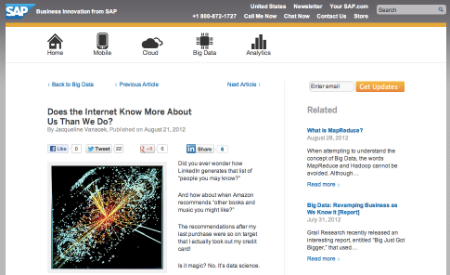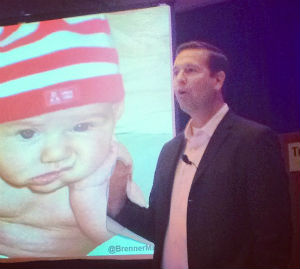Content Marketing: Why to How with Business Innovation from SAP
Building the case for content marketing is an ongoing battle and while a huge number of companies are not on board with “brand as publisher” yet, many are. They “get it” but are in search of more practical advice on the how.
That’s what Michael Brenner, Senior Director, Global Integrated Marketing and Content Strategy at SAP and co-founder of Business to Community provided at the MarketingProfs B2B Forum last week in his session: Content Marketing: Moving From the “Why” to the “How”.
The world is changing faster than we can keep up with. Just a few years ago, no one used terms like “social media”. Today, it’s unusual not to. We went from not sharing much of anything to sharing a lot. Our kids are going to grow up with virtually everything digitally documented.
We are experiencing an Information Revolution.
There are more than 7 billion connected devices today. News and information have always been important for B2B marketing. We are now the best source of news vs. industry media outlets alone. Some stats on the state of media and consumers:
- Marketers are bombarded with 2-5k marketing messages per day
- 2/3 of Americans have joined the US do not call list
- 86% of people skip TV ads
- 44% of direct mail is never opened
- 99.9% of banner ads do not receive clicks
- 90% of emails are never opened and 99.5% don’t produce a single click
The conclusion?
"Your Marketing Sucks"
B2B Marketers need to let their customers, communities and prospects know that they care. The B’s in BtoB are people too.
Current situation: Identify keywords that represent early stage queries. Generic, top of funnel terms. Ask: How much of the website traffic you’re getting fall into early state vs. later stage terms? In the case of SAP, early stage terms were 3 out of every 10,000. That was a big content problem. But that also meant an opportunity, solved with a better content marketing strategy.
"Effective content marketing is a cycle of SEO to get found, get shared via social and get leads (conversions)."
[Great minds think alike!]
Content Strategy: Get the content your audience needs and delivered in all the places they go. Do this for each persona, for each stage of the buyer journey, for all media channels and requires created, curated and syndicated content.
Case Study: Business Innovation from SAP

Goal: to earn relationships instead of buying them. The Business Innovation from SAP site emulates Adobe’s CMO.com. Also, to become a destination of business innovation insights through education and information on how to innovate against todays top business challenges to gain a competitive advantage.
The site delivers content the audience wants. It’s educational, not promotional. Because it’s helpful, people self select to decide to continue on to the SAP corporate website to engage. Daily updates, social shares and comments keep people interested and interactive. Subtle branding and appropriate CTA to explore SAP solutions are included. The Business Innovation from SAP site syndicates content from hundreds of authors (75% external). While there are many who can be critical of it, Klout was effectively used to identify people that were influential on specific topics.
Contributors cross post their content to the Business Innovation site. The SAP site uses canonical tags and “author rel” markup to let Google know where the original content resides.
The Result? 100k pageviews a month and hundreds of leads SAP would never have seen otherwise.
Similar examples: AMEX Open Forum, Adobe CMO.com, IBM InfoBoom & BCGPerspectives.
The buyer’s journey starts with a search question. Look at the question from of all the search phrases you’re advertising for. Then create content to answer those questions.
- Over 200 contributors from 30 feeds at no cost to SAP.
- 1000’s of articles published – average of 8 per day
- 200k visits, 236k unique visitors, 395k pageviews per month. Average 4.1 min per visit.
- 100s of inbound links, 10% of traffic is from social sharing.
- 15% conversions to SAP.com (deep link traffic to technical and product content on company site), more than 127 registrations, 334 clicks on “buy now”, call or chat.
- Within 2 months, a 600% return on investment. Investment was $15k to setup a WP blog.
SAP aspires the Business Innovation site to become the “Business Week” of technology innovation.
On Michael’s personal site, Business to Community, the formula for the content that is most popular:
- Top 50 Influencers
- Top 10 Blog Sites
- Terms You Need to Know
- Myths…Busted
- 10 Predictions for
- What is
- The First Steps to Success in
- How to Get Ahead With
Articles covering these topics, generated 10x of the traffic that other content has attracted.
Key Content Marketing Challenges and Recommendations:
Audience based content – Social first content supply chain. Create as much content as possible to get found, shared and leads to a conversion. Talk to customer service reps and other front line employees to get ideas.
Scale – To scale, you need content, channel strategy, evangelists, curators, creators. Companies must understand the primary marketing asset they need to create is content.
Gating – Training and education. There’s a balance between how much information is in demand vs. how much information a prospect will provide to see it.
Lack of external voices – Curation strategy: influencesrs, partners, media. Prospects want to hear from more than your internal thought leaders. Publish information that’s helpful to customers, even if a competitor is included and your brand is not. That can inspire internal thought leaders to step up.
Metrics for success – Percent of early stage search traffic, engagement and conversion. What percentage of leads come from inbound sources? The answer to that question is a proxy to how well your content is doing. How well is content that answers customer initial questions doing at engaging them into the sales funnel?
Offers – No “master” offer strategy that have broad early stage appeal.
Syndication – Need to get the content out there using partnerships and services like Outbrain.
To view the full presentation, Michael was kind enough to post it to Slideshare which I have embedded below:

No comments:
Post a Comment